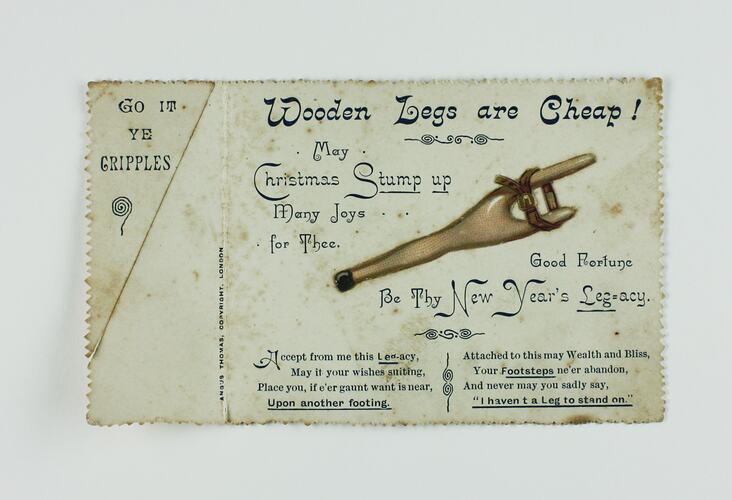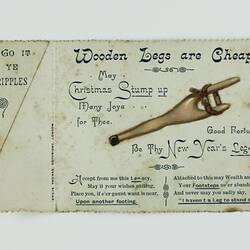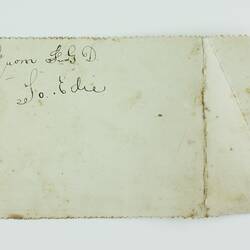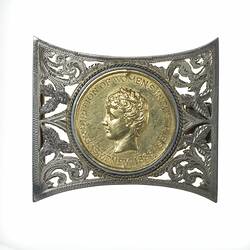Summary
Humorous Christmas card, World War I era, inscribed 'Wooden Legs are Cheap!' - 'GO IT YE CRIPPLES!', with image of a wooden leg. The card includes a range of word puns about limblessness. It is addressed from JGD [?] to Edie.
The card relates to the World War I experiences of Charles John Clark (known as Chas, or 'Pop' to his later offspring). 'Edie' (Edith) was his sweetheart during the war, and later became his wife. The card makes light of the loss of a limb in war - a way of coping with a devastating injury - and also parodies the cheerfulness with which war-time injuries were sometimes regarded in the interests of public morale. Marina Larsson notes the wounded soldiers were often reluctant to reveal their own trauma and distress, subscribing to Edwardian codes of manliness which considered feelings a sign of weakness.
Charles John Clark, service number 1922, enlisted on 13 January 1915, at the age of 20. He had no specified trade or calling, and lived in Caulfield. He was placed in the 6th Battalion, 5th Reinforcements, and was later transferred to the 58th then the 60th Battalion. He embarked on 17 April 1915, and served in Gallipoli. After the Gallipoli withdrawal he was sent to Europe, disembarking in France on 29 June 1917. He experienced several near misses, at one stage being shot but saved by a tin (possibly used as a mirror) stored in his shirt pocket. His luck ran out less than a month after he arrived in France, on 19 July, when he received severe gunshot wounds to his left shoulder and left thigh. On 2 August he was sent to England for treatment at Harefield House Hospital (No. 1 Australian Auxiliary Hospital) in Middlesex (the matron at Harefield at that time was the Australian Nellie Gould, whose prize medal mounted in a belt buckle is held by Museum Victoria - NU 20556). Chas returned to Australia in October 1917, and was discharged from service 'permanently unfit for service of any kind' 20 June 1918. Tuberculosis added to his suffering.
After the War Chas became a potter, apprenticed under Merrick Boyd, and also worked as a gardener, although his war injury precluded some types of physical work. He received a grant to purchase a house opposite the Sunshine Harvester factory under the War Service Homes Act, and was proud that his war experience had allowed him to provide for his family. During the Depression, however, when work was hard to find, he and Edie closed up their house in Sunshine and moved temporarily to Creswick to live with other family members as a way of saving money (their families had both originally come from Creswick). He made just enough money panning gold to keep their Sunshine home. Chas and Edie had a long and happy marriage, and raised two children. His family remember him as a gentle, wise man.
Chas did not discuss his war experiences in any depth, and would retreat to his shed from time to time for solace, where he began to paint after his retirement. However, he would occasionally pull out mementoes - coins, photos, the bullet-damaged tin - and share his memories of the comradeship of war, albeit a very edited account. He walked with a limp due to his war wound, and used a walking stick. Later in life his tuberculosis again caused him ill-health. He passed away in 1985, at the age of 91.
Physical Description
Off-white Christmas card, horizontal, with fold near one end, and diagonal fold across that portion. The card has a sepia-coloured drawing of a wooden leg with leather band at thigh (to secure leg). Printed inscription above and below. Hand-written inscription on reverse. Edges finely pinked. Card is yellowed, with foxing in places.
More Information
-
Collecting Areas
-
Acquisition Information
Donation from Penny-Ann Clark, 24 Jul 2013
-
Publisher
-
Sender
Charles J. Clark
Probable sender - initials difficult to decipher -
Inscriptions
Printed in blue on card: 'Wooden Legs are Cheap! / May / Christmas Stump up / Many Joys / for Thee. / Good Fortune / Be Thy New Year's Leg-acy ['leg' is underlined]. / Accept from me this Leg-acy, / May it your wishes suiting, / Place you, if e'er gaunt want is near / Upon another footing. [ underlined]. / Attached to this may Wealth and Bliss, / Your Footsteps [underlined] ne'er abandon, / And never may you sadly say / "I haven't a Leg to stand on." [underlined].' To left, on folded portion of card, 'GO IT / YE / CRIPPLES'. Printed vertically, in small font: 'ANGUS THOMAS, COPYRIGHT, LONDON'. Hand-written in brown ink on reverse: ''Fred G D / To Edie'.
-
Classification
-
Category
-
Discipline
-
Type of item
-
Overall Dimensions
123 mm (Width), 73 mm (Height)
-
Keywords
World War I, 1914-1918, Correspondence, Christmas Cards, Humour



